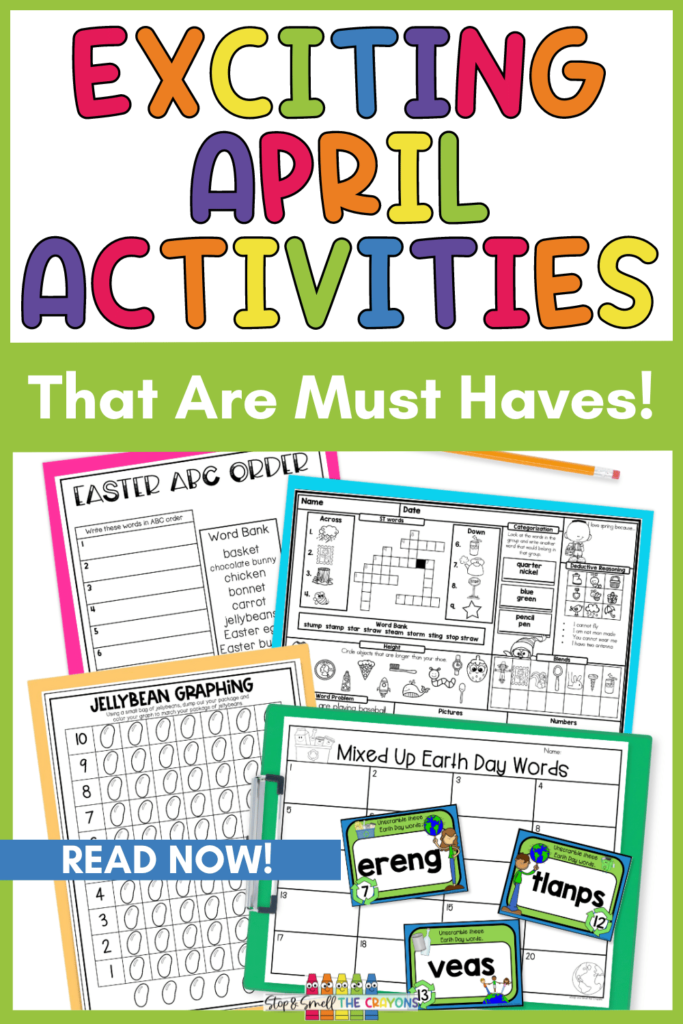April brings that extra burst of energy, propelling us forward to tackle everything on our end of the year to do list. Coming off the relaxing spring break, there’s a renewed sense of motivation in the air. But. . . there is a lot to do in April. At times, it feels like we blink, and April’s gone. To make those to-do lists more manageable, I’ve rounded up my favorite April activities that work like magic for both math and literacy. My students look forward eagerly to these activities for morning work, partner work, and during our center rotations. Here’s hoping your students enjoy them just as much!
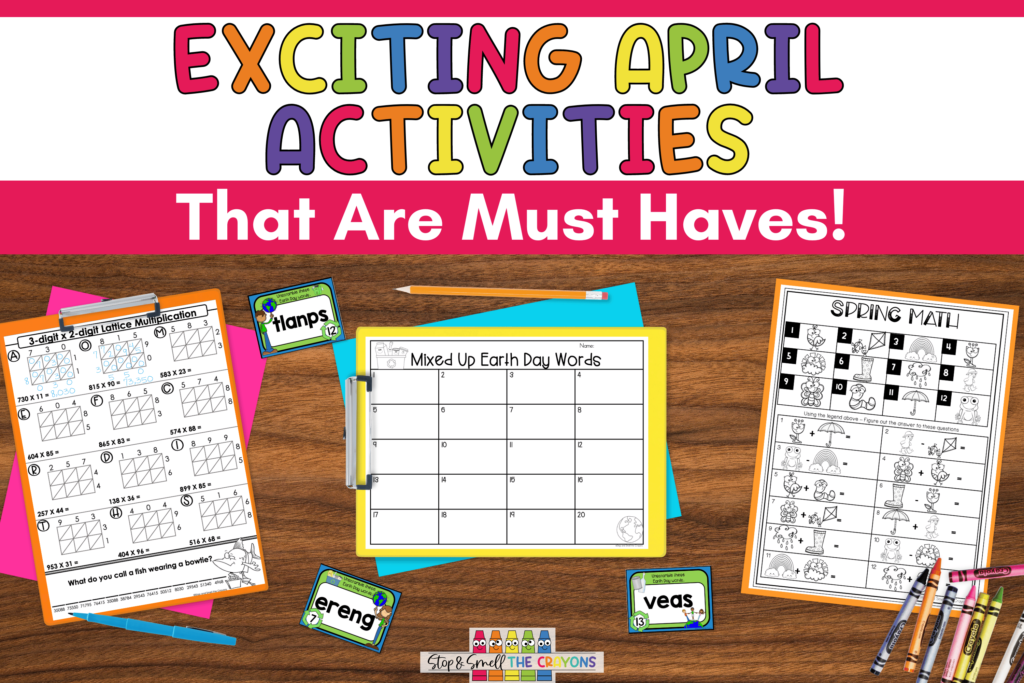
Start The Day With Morning Work Pages

I enjoy kicking off my students’ day with a morning work page right at their seats. As we know, our students tend to trickle in at different times, some bright and early, others fashionably late. Having morning work in place establishes a structured routine and lessens the chaos of mornings. It ensures they know exactly what to dive into once they’ve unpacked. These April morning work pages are full of activities that mix math and literacy skills. What’s even better is that it’s a spiral review, weaving those essential skills throughout.
If the morning rush is too much, these activities can be used differently! I’ve also made these April activities into a nifty booklet format. Print and staple, and they’re perfect for early finishers to tackle. I’ve cycled them through our centers and even sent them home for independent work or a bit of extra practice. They’re adaptable to become what you need them to become!
No Prep Math and ELA April Activities
When I create resources to use with my kiddos, I always try to make ones that can be flexible and beneficial in reviewing skills. Then, I love to add a fun theme to give them some background information on the time of year. I have three sets of math and ELA worksheets that will have your students excited for independent work time, centers, or more morning work options!
No Prep Worksheets for Easter, Earth Day, and Spring Equinox
In my Easter Literacy and Math set, my students have a blast learning a little about what Easter is through a short passage. From there, they get to dive into engaging activities from crosswords to vocabulary work to graphing. Everything you need to have a successful center or for general work time is a simple click and print away!

The Earth Day Literacy and Math set is very similar to the Easter set with some additional activities! The set starts with a short passage and comprehension questions about Earth Day. Then, you can mix and match the language arts skills you want your students to practice. Options include a variety of skills like vocabulary, alphabetical order, and choosing the correct spelling words. One of my student’s favorite activities is the I Spy activity page.
In the Spring Literacy and Math set, my students learn about the Spring Equinox! Just like the other two sets, I introduce my students to the Spring Equinox through a reading passage and questions. Then they work through the themed activities to practice key vocabulary based around the Spring Equinox. They keep their math skills sharp with the themed activities for adding, subtracting, multiplying, graphing, and using the 100’s chart.
Celebrate Earth Day With These April Activities!
Earth Day is a fun holiday to celebrate with students in April. I’ve got a range of activities tailored for your classroom that you can use to celebrate the day! You can start with the No Prep Math and Literacy activities above, and then add these to your centers.
Earth Day Write the Room
My kiddos always love it when I post these scrambled word cards around the room, so I put an Earth Day twist on them this time! The setup is quick and simple. All I do is print them out and tape them up around the room.
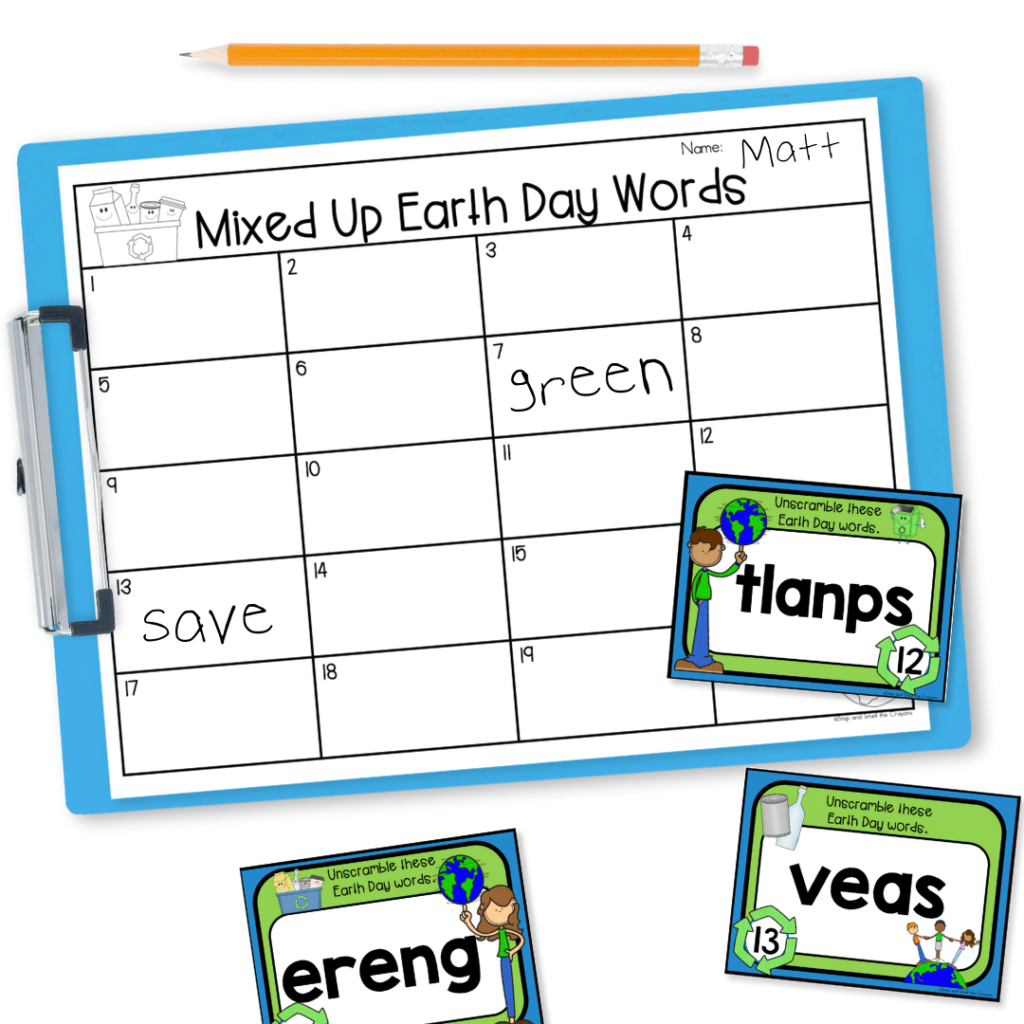
When it’s time for this activity, my kiddos grab a clipboard to hold their recording page and be able to write as they walk around the room. When they approach a card, they are going to see a scrambled-up word that connects to Earth Day. For example, paper, earth, and flowers. The students’ mission is to unscramble each one correctly.
This is a great way to work on spelling and vocabulary. I usually have students work with a partner to combine their brainpower! These Earth Day task cards are always present in my literacy centers during April. Once they are cut and the recording page is printed, they are ready for your kiddos!
Earth Day Sight Word Write the Room
I have another Write the Room activity, but this one focuses on sight words and adds the mystery of coded words. On each task card students find a series of little Earth Day symbols next to each other. Their task is to go to their decoder and figure out which symbol represents which letter of the alphabet. Once they have a letter, they go on to the next until they have created a sight word! They enjoy the challenge of matching the symbol with the letter and being able to move around.
Earth Day Coloring Pages
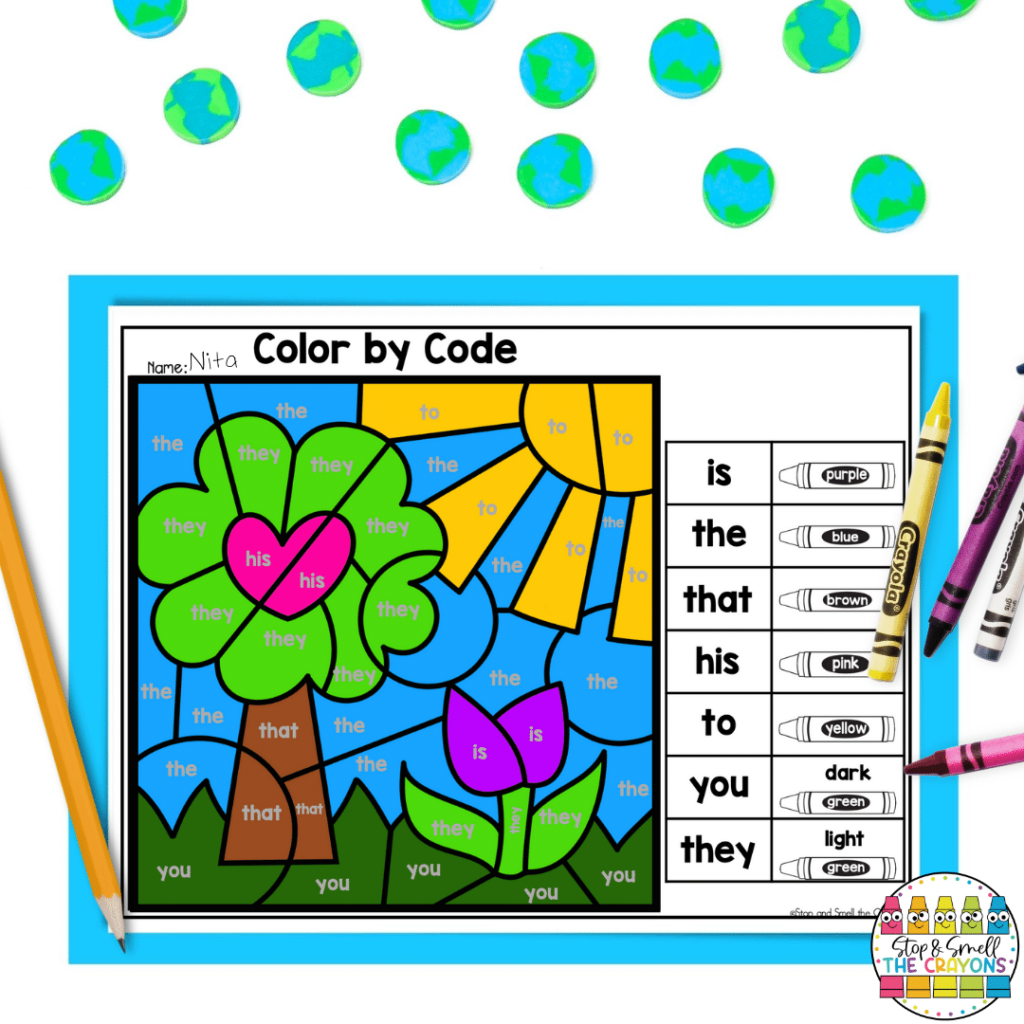
No holiday or special day is complete without some themed coloring pages! While I’m a big fan of coloring fun, I also want to sneak in some literacy skills practice for my kiddos. I created these delightful Earth Day pictures that turn the hunt for sight words into a colorful adventure. Each sight word comes paired with a specific color. So, as they spot and identify the words within the image, they fill in the space with that particular color.
These activities are the definition of low-prep April activities. They provide a subtle Earth Day twist to our simple sight word reviews. I sprinkle these pages into our morning work routine, toss them into the mix during center rotations, or hand them out to my early finishers for extra literacy engagement.
Earth Day Math Logic Puzzles
One of my favorite April activities are these math logic puzzles. This is one of those activities that really shows how much my students have grown from the beginning to the end of the school year. There are many different ways to use these puzzles in your room.
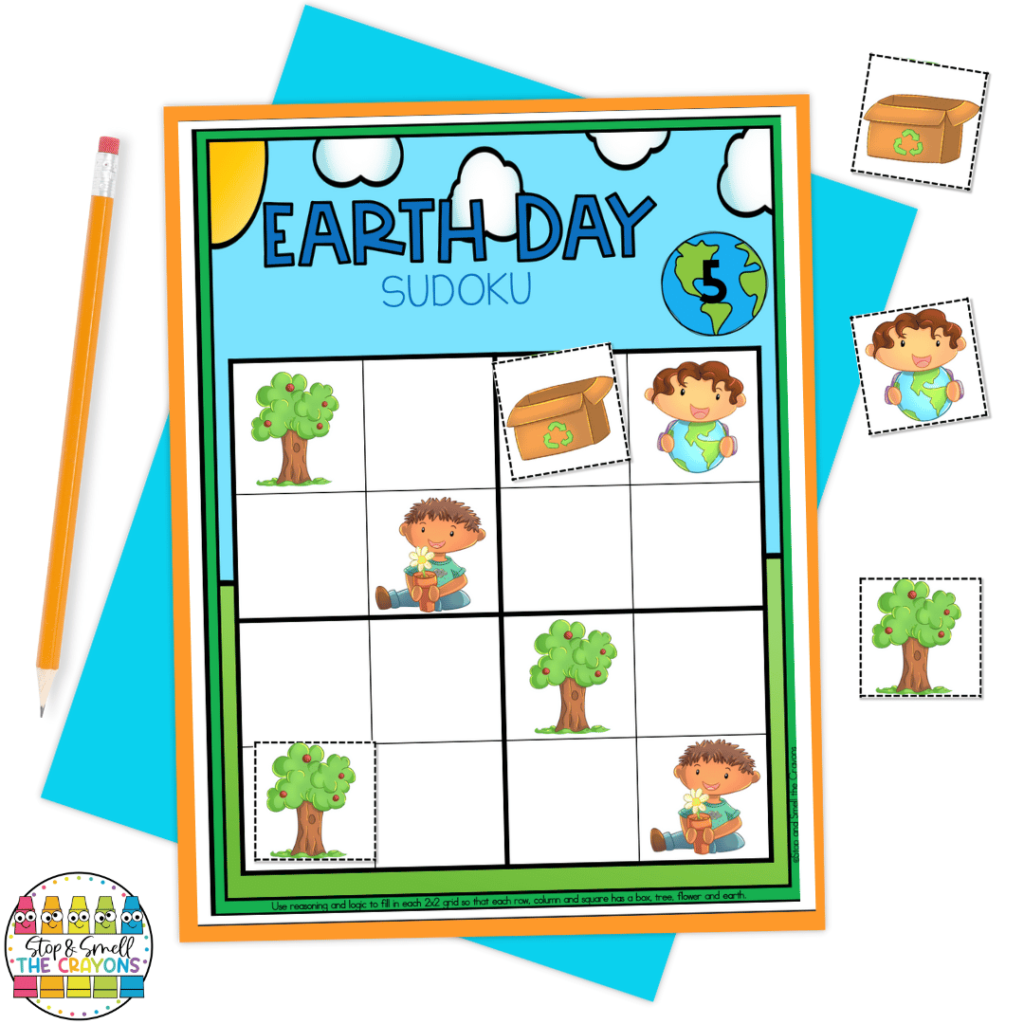
By April, my students usually work on these independently during our center time. At the start of the year, we do this as a whole class to learn the vocabulary and how to solve them. We talk about how there can only be one of each symbol in a column and a row. There can’t be two of the same symbol in the column or row. Each 2 x 2 square should also only have one of each symbol.
I find that the sooner they can move the pieces themselves, the better it is to help with their understanding. I usually project the puzzle on the board. Then, I laminate and place magnets onto the back of the symbols. I have students come up to the board to place the symbols, keeping in mind the rules. When we get stuck, we talk it out and stretch our thinking. Slowly but surely, they’ll start to get the hang of it. When they do, I make one of the math centers digital. I have a puzzle board projected, and their task at the center is to solve the puzzle!
These particular April activities promote lots of great conversation. We talk about perseverance and having a growth mindset. I explain that it’s okay to feel frustrated, but that we can keep trying and learning as we go. Then we celebrate once we solved our puzzle!
April Activities for Multiplication Practice
You know how life gets hectic, and you pick up a skill, only to let it slide when things get busy? It happens to the best of us, right? Well, just like us adults, our students can face the same challenge. That’s why I believe in keeping them on their toes, especially in math. Here are some multiplication activities I’ve got up my sleeve to make sure my students stay sharp, even in those last few months of the school year!
Easter Color By Number 2 Digit x 2 Digit Multiplication
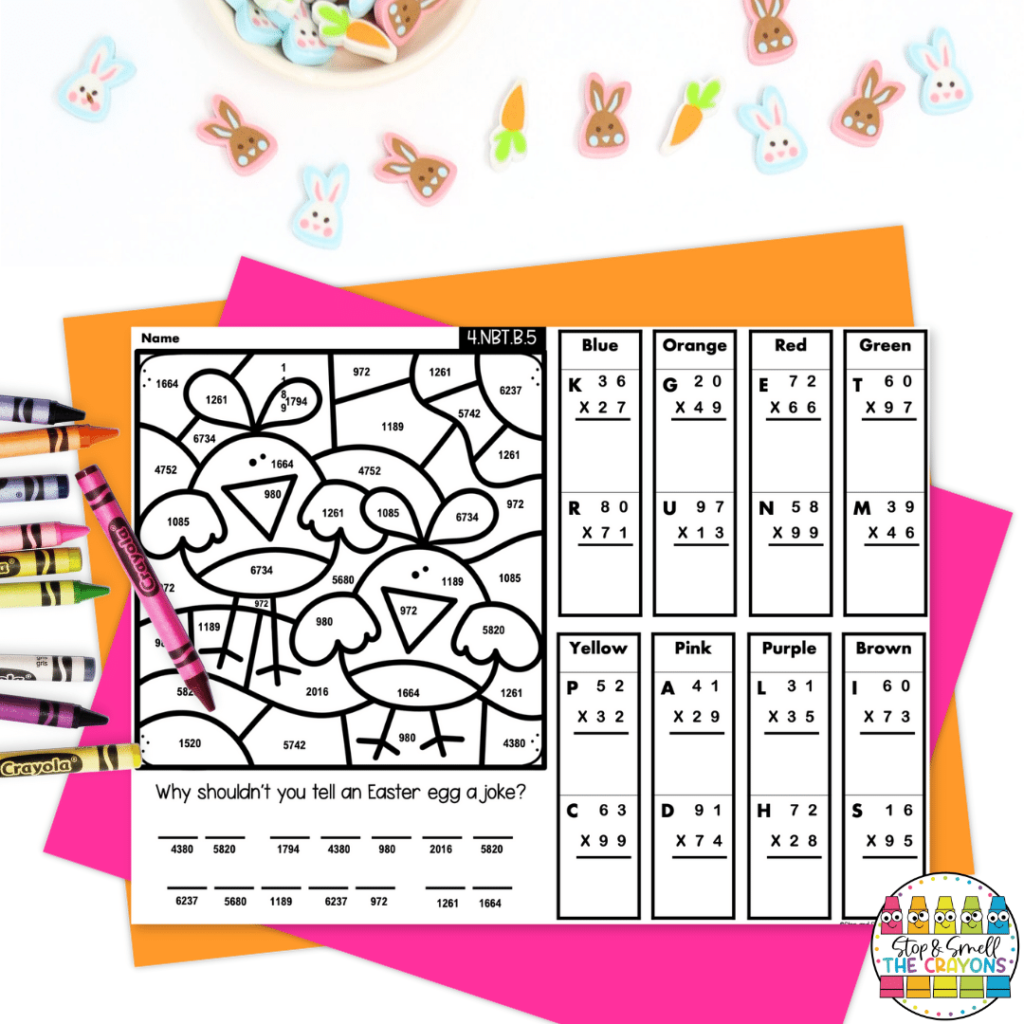
Math can bring out the nerves in some of my kiddos, so I try to incorporate activities that make math more approachable. These color by number activities are perfect to add to the mix of your April activities because of their simplicity. The coloring part helps to make math fun, which makes our students more willing to do their math!
These coloring pages have an extra something to them! Students work through each of the multiplication problems on looseleaf to have room to show their work. They can self-check their answers by looking underneath the picture to see if their answer is listed. If it is, then they can write the letter that is next to the problem they just solved. By the end, they should reveal an Easter joke! Once the letter has been written, they go up to the picture to color in their answers based on the color at the top of the column of math problems to slowly start revealing the image.
Cootie Catcher for Multiplication Tables
The more we practice the more progress we make! This a mantra my students and I say together. I always tell them I don’t expect perfection. I do say I expect practice; otherwise, we can’t improve our skills or ourselves.
To practice a skill or concept, you have to be able to access it. All of my students learn differently and have various preferences when practicing their multiplication tables. Some prefer the flashcard approach, and others like writing them out on looseleaf. The majority love the interactiveness of the cootie catcher.
I guide my students through the cutting and folding portions to create a cootie catcher that reviews the different multiplication tables. They have a blast asking each other to choose which flap to lift to reveal the number they’re going to be multiplying by. No more memorizing the facts in order! The interactive component is a complete game-changer to their practice time. I make sure I have these accessible for math centers, review sessions, and early finishers.
April Activities for Lattice Multiplication Practice
All of our learners have different learning styles. Sometimes, it almost feels like we are hitting our heads against a wall because one approach isn’t working. You wish you had more tools in your toolbox, I get it!
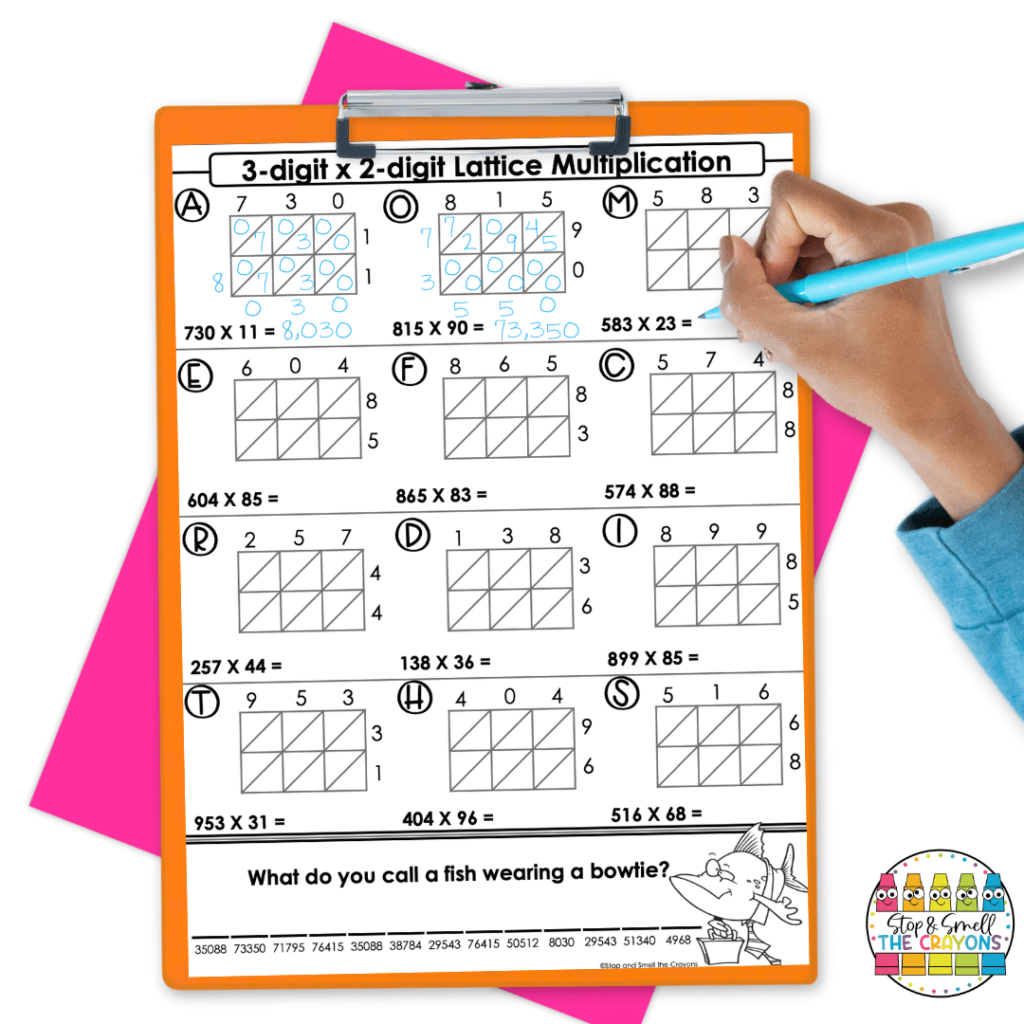
I’ve been in that same headspace until I discovered lattice multiplication. This approach is effective and offers a fresh perspective. It ranks up with all the other traditional methods like the algorithm, area model, distributive property, and box model. I’ve covered all of these methods in my teaching journey, but the lattice method is a complete package.
These worksheets provide your kiddos a chance to practice the 3-digit x 2-digit lattice multiplication method with an extra twist. When they solve a multiplication problem they’ll reveal a letter that unlocks a collection of “bad dad riddles”. Dad jokes are kind of a weakness of mine because some are surprisingly good. I love any chance I can bring laughter to math time, so I combined the two! These jokes act as an incentive for my kids and become a motivator for them to keep working through the problems. I’ll be honest. The reactions to the jokes are mostly groans, but I know deep down they love them!
Check out the 2-digit x 2-digit lattice multiplication and the 3-digit x 3-digit lattice multiplication practice pages for more math fun!
April Activities Engage Your Students
These April activities have proven to be a hit in my classroom and powerful tools for engagement and practicing skills. While my students are invested in the activities, it cuts down on distractions and behaviors that might pop up during this time of year. By weaving in skills they’ve learned throughout the year, these activities are the perfect balance between fun and learning.
As we dive into the last few months of the school year, I can teach with ease, knowing my students are having a blast while strengthening their knowledge. Here’s to a lively and educational April in the classroom! Looking for additional resources with a Spring or Easter theme? Make sure to explore my March Activities post, where I have gathered even more engaging resources!
Save for Later
Remember to save this post to your favorite teacher Pinterest board to help complete your lesson plans for April!
